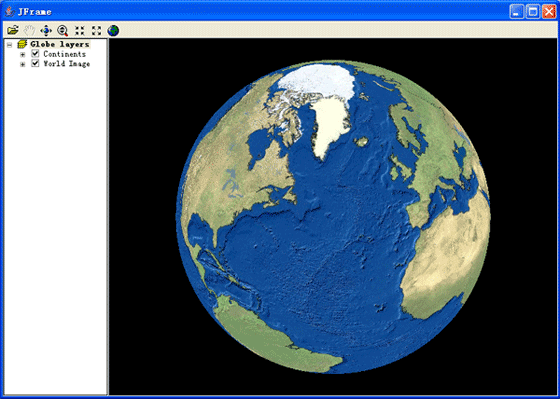作者:Flyingis
ArcEngine开发文档中提供了另外一个开发简例HelloGlobe,它是基于JFrame窗体的一个简单应用,从窗体设计代码中我们可以看到,ArcEngine已经以JavaBean的形式封装了一些常用的窗体控件,可以直接的应用到窗体设计的开发中,并且支持跨平台,给开发者提供了另一种选择。
引用的包:
 import java.awt.BorderLayout;
import java.awt.BorderLayout;
 import java.awt.event.WindowAdapter;
import java.awt.event.WindowAdapter;
 import java.awt.event.WindowEvent;
import java.awt.event.WindowEvent;
 import java.io.IOException;
import java.io.IOException;
 import javax.swing.JFrame;
import javax.swing.JFrame;

 import com.esri.arcgis.beans.TOC.TOCBean;
import com.esri.arcgis.beans.TOC.TOCBean;
 import com.esri.arcgis.beans.globe.GlobeBean;
import com.esri.arcgis.beans.globe.GlobeBean;
 import com.esri.arcgis.beans.toolbar.ToolbarBean;
import com.esri.arcgis.beans.toolbar.ToolbarBean;
 import com.esri.arcgis.controls.ControlsGlobeFullExtentCommand;
import com.esri.arcgis.controls.ControlsGlobeFullExtentCommand;
 import com.esri.arcgis.controls.ControlsGlobeNavigateTool;
import com.esri.arcgis.controls.ControlsGlobeNavigateTool;
 import com.esri.arcgis.controls.ControlsGlobeOpenDocCommand;
import com.esri.arcgis.controls.ControlsGlobeOpenDocCommand;
 import com.esri.arcgis.system.AoInitialize;
import com.esri.arcgis.system.AoInitialize;
 import com.esri.arcgis.system.EngineInitializer;
import com.esri.arcgis.system.EngineInitializer;
 import com.esri.arcgis.system.esriLicenseExtensionCode;
import com.esri.arcgis.system.esriLicenseExtensionCode;
 import com.esri.arcgis.system.esriLicenseProductCode;
import com.esri.arcgis.system.esriLicenseProductCode; 关于AWT和Swing的使用可以参考相关的书籍,从引用的包中,可以看到TOC、toolbar、globe显示窗都已经封装到JavaBean中,可以直接调用,为开发者省了不少事,也帮助开发人员可以像在Visual Studio下设计UI一样来设计Java的窗体。
看看它的窗体设计代码:
 //
//
 // Create and display the frame
// Create and display the frame
 //
//

 private void display() throws IOException
private void display() throws IOException  {
{
 setSize(500, 400);
setSize(500, 400);
 //
//
 // Create the globe, toolbar, and table of contents beans.
// Create the globe, toolbar, and table of contents beans.
 //
//
 GlobeBean globeBean = new GlobeBean();
GlobeBean globeBean = new GlobeBean();
 ToolbarBean toolbarBean = new ToolbarBean();
ToolbarBean toolbarBean = new ToolbarBean();
 TOCBean tocBean = new TOCBean();
TOCBean tocBean = new TOCBean();
 //
//
 // Add beans to the content pane.
// Add beans to the content pane.
 //
//
 getContentPane().add(toolbarBean, BorderLayout.NORTH);
getContentPane().add(toolbarBean, BorderLayout.NORTH);
 getContentPane().add(globeBean, BorderLayout.CENTER);
getContentPane().add(globeBean, BorderLayout.CENTER);
 getContentPane().add(tocBean, BorderLayout.WEST);
getContentPane().add(tocBean, BorderLayout.WEST);
 //
//
 // Add commands and tool to the toolbar.
// Add commands and tool to the toolbar.
 //
//
 toolbarBean.addItem(new ControlsGlobeOpenDocCommand(), 0, -1, false, 0, 1);
toolbarBean.addItem(new ControlsGlobeOpenDocCommand(), 0, -1, false, 0, 1);
 toolbarBean.addItem(new ControlsGlobeNavigateTool(), 0, -1, false, 0, 1);
toolbarBean.addItem(new ControlsGlobeNavigateTool(), 0, -1, false, 0, 1);
 toolbarBean.addItem(new ControlsGlobeFullExtentCommand(), 0, -1, false, 0, 1);
toolbarBean.addItem(new ControlsGlobeFullExtentCommand(), 0, -1, false, 0, 1);
 //
//
 // Buddy up the globe with the toolbar and table of contents.
// Buddy up the globe with the toolbar and table of contents.
 //
//
 toolbarBean.setBuddyControl(globeBean);
toolbarBean.setBuddyControl(globeBean);
 tocBean.setBuddyControl(globeBean);
tocBean.setBuddyControl(globeBean);
 //
//
 // Shutdown ArcObjects when the window closes.
// Shutdown ArcObjects when the window closes.
 //
//

 addWindowListener(new WindowAdapter()
addWindowListener(new WindowAdapter()  {
{

 public void windowClosing(WindowEvent e)
public void windowClosing(WindowEvent e)  {
{

 try
try  {
{
 new AoInitialize().shutdown();
new AoInitialize().shutdown();
 System.exit(0);
System.exit(0);
 }
}

 catch (IOException ex)
catch (IOException ex)  {
{
 System.out.println(ex.getMessage());
System.out.println(ex.getMessage());
 System.exit(1);
System.exit(1);
 }
}
 }
}
 });
});
 setVisible(true);
setVisible(true);
 }
}
纯粹的Java窗体设计风格,简单易用。再看看main方法中的内容,和前面一篇《AE92 SDK for Java 最小示例学习》稍有区别。
main方法:

 public static void main(String args[])
public static void main(String args[])  {
{

 try
try  {
{
 EngineInitializer.initializeVisualBeans();
EngineInitializer.initializeVisualBeans();
 AoInitialize aoInitializer = new AoInitialize();
AoInitialize aoInitializer = new AoInitialize();
 aoInitializer.initialize(esriLicenseProductCode.esriLicenseProductCodeEngine);
aoInitializer.initialize(esriLicenseProductCode.esriLicenseProductCodeEngine);
 aoInitializer.checkOutExtension(esriLicenseExtensionCode.esriLicenseExtensionCode3DAnalyst);
aoInitializer.checkOutExtension(esriLicenseExtensionCode.esriLicenseExtensionCode3DAnalyst);
 HelloGlobe thisApp = new HelloGlobe();
HelloGlobe thisApp = new HelloGlobe();
 thisApp.setTitle("Hello, Globe!");
thisApp.setTitle("Hello, Globe!");
 thisApp.display();
thisApp.display();
 }
}

 catch (IOException ex)
catch (IOException ex)  {
{
 System.out.println(ex.getMessage());
System.out.println(ex.getMessage());
 }
}
 }
}
由于应用程序使用了窗体,因此在原始AO组建和Java Class建立关联时,需要initializeVisualBeans方法来初始化,initializeVisualBeans和initializeEngine两者选其一,使用可视化Beans选择前者,否则选择后者。这里aoInitializer对象除了指定相应的license授权,还检查相应的应用扩展。
AE92 SDK for Java 已经集成到Eclipse3.2中,通过ArcEngine模板建立一个HelloGlobe工程,看看运行显示的结果:

基于这个模板框架,可以方便我们深入扩展Globe二次开发的功能。